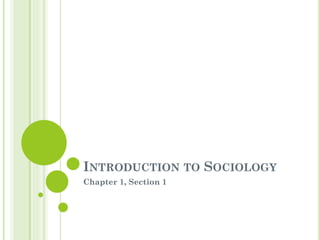
Introduction to Sociology Chapter 1 Perspectives
- 1. INTRODUCTION TO SOCIOLOGY Chapter 1, Section 1
- 2. WHAT IS IT? Sociology= studies human society and social behavior in a scientific manner. Look at two main aspects of society: Social interaction= how people relate to one another and influence one another’s behavior. Social phenomena= observable facts or events in human society.
- 3. WHY DO PEOPLE STUDY SOCIOLOGY? 1) Understand how behavior is influenced by social factors. 2) Learn how to view the world through others’ eyes • Look beyond common beliefs and find hidden meanings= sociological perspective. 3) Attempt to balance one’s personal desires with their social environment. • Connect the larger world with personal life= sociological imagination. 4) Find your ‘place’ both within society and history.
- 4. SOCIOLOGY AS A SOCIAL SCIENCE Sociology is one of 6 social sciences. A social science studies human behavior, institutions or functions of human society in a scientific manner. Other social sciences: Anthropology Psychology Economics Political science History
- 5. SOCIAL SCIENCES What do each of the other social sciences look at? (Be able to explain each in your own words) Anthropology– cultures of past, less-advanced societies. Psychology– focuses on individual behavior. Economics– study of choices people make; how people are affected by economic factors. Political science– organization and operation of government. History– study of past events; how past events affect current behaviors and attitudes.
- 6. SOCIOLOGICAL PERSPECTIVES Chapter 1, Section 2
- 7. HOW SOCIOLOGY STARTED Sociology did not develop until the 1800s. Sociology developed in Europe, because of changes as a result of the Industrial Revolution. People left their homes in the countryside and came to cities. As cities became crowded, people began to interact on a closer scale than ever before. Social problems such as housing shortages, crime, and lack of jobs arose. The desire for individual rights amongst society led to the American and French Revolutions.
- 8. THE EARLIEST SOCIOLOGISTS Auguste Comte French (1798-1857) “father” or “founder” of sociology-- coined the term believed that sociologists should worry about two problems: order and change social statics = overall structure of a society remains unchanged social dynamics = elements within the society change to allow for social development “cerebral hygiene” - attempt to keep his mind pure.
- 9. THE EARLY SOCIOLOGISTS (CONT’D) Herbert Spencer English (1820-1903) Adopted a biological view of society– saw society as an organism Influenced by Charles Darwin Coined the phrase “survival of the fittest” Social Darwinism Advocated against social reform efforts because it would disrupt the natural selection process of evolution The best traits of society would survive over time
- 10. THE EARLY SOCIOLOGISTS (CONT’D) Karl Marx German (1818-1883) Structure of society is influenced by how its economy is organized. There are two classes, the bourgeoisie and the proletariat. The bourgeoisie own the means of production and the proletariat provides labor. The imbalance of power between the two classes would lead to rebellion.
- 11. THE EARLY SOCIOLOGISTS (CONT’D) Emile Durkheim French (1858-1917) First to apply scientific principles to study of society. Study directly observable features. Saw society as a series of interrelated parts, but the function(s) of these parts was his focus. Function= a consequence that an element of society produces in order to maintain the social system. Specifically looked at religion. 1897 study Suicide was the first of its kind
- 12. THE EARLY SOCIOLOGISTS (CONT’D) Max Weber Prussian (1864-1920) Focused on the groups within a society rather than society as a whole. What is the effect of society on the individual? Believed in the use of Verstehn to put yourself in someone’s place to study meanings behind an individual’s actions. Created the term ideal type to refer to the essential characteristics of a feature of society.
- 13. THE THREE PERSPECTIVES Theory= explanation of relationships among phenomena. Theoretical perspective= a ‘school of thought’, outlining specific ideas about the nature of social life. Three perspectives: Functionalist Conflict Interactionist
- 14. THE THREE PERSPECTIVES Chapter 1, Section 2 (cont’d)
- 15. FUNCTIONALISM Emphasizes function of social parts Family, religion etc. See social parts as in integrated whole society Patterns of unrest, change, integration and stability Consensus on social values Social Change Social Integration Stability Social Unrest Functionalist Perspective
- 16. FUNCTIONALISM TERMS Manifest functions of institutions are open, stated, conscious functions. They involve the intended, recognized, consequences of an aspect of society. Latent functions are unconscious or unintended functions and may reflect hidden purposes of an institution. A dysfunction is an element or a process of society that may actually disrupt a social system or lead to a decrease in stability.
- 17. CONFLICT PERSPECTIVE Permanent social conflict Competition for interests and value Power and who gets what Change occurs when power shifts powershift conflict Power shift conflict Conflict Perspective
- 19. WHAT DOES THE TITANIC HAVE TO DO WITH IT? Not exactly ‘fair’, is it?
- 20. SYMBOLIC INTERACTIONISM Focuses on interactions between people Establish meaning from reaction to symbols Base behaviors on these symbols Imagine how others might react to symbols Interact based On observations Predict Social behaviors Based on interactions Learn meaning through observation
- 21. INTERACTIONS MEAN DIFFERENT THINGS TO DIFFERENT INDIVIDUALS
- 22. REVIEW: WHICH IS FUNCTIONALISM, CONFLICT PERSPECTIVE, OR SYMBOLIC INTERACTIONISM Societies are in relative balance F Power is the most important element in life C Religion helps hold together a society morally F Symbols are crucial to social life S/I Many element exist in society to benefit the powerful C Social change is constantly occurring C Conflict is harmful and disruptive to society F